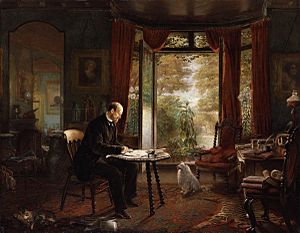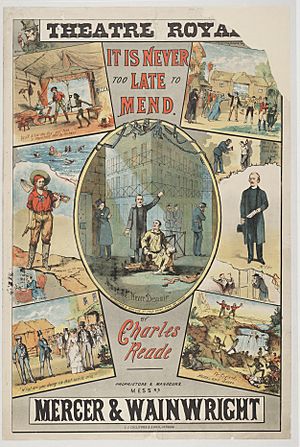Charles Reade facts for kids
Charles Reade (born June 8, 1814 – died April 11, 1884) was a British novelist and dramatist (someone who writes plays). He is most famous for his novel The Cloister and the Hearth.
Contents
Charles Reade's Early Life and Education
Charles Reade was born in Ipsden, Oxfordshire. His parents were John Reade and Anne Marie Scott-Waring. He had at least four brothers.
He went to Magdalen College, Oxford, a famous university. He earned his first degree in 1835. Later, he became a "fellow" of his college, which means he was a senior member or teacher. He also earned a higher degree in 1847. In 1836, he started studying law at Lincoln's Inn and became a lawyer in 1843. Even though he became a lawyer, he spent most of his time in London after finishing his studies. He kept his fellowship at Magdalen College throughout his life. His nephew, William Winwood Reade, became a well-known historian.
Charles Reade's Plays and Novels
Charles Reade started his writing career by creating plays. He even wanted "dramatist" to be the first word on his tombstone. When he wrote, he always thought about how scenes and dialogue would look and feel on a stage.
His first play, The Ladies' Battle, was shown in May 1851. Other early plays included Angela (1851) and Gold (1853).
A play called Masks and Faces made him famous. He wrote it with Tom Taylor in 1852. Later, he turned this play into a book called Peg Woffington (1853). That same year, he wrote Christie Johnstone, which was a detailed story about Scottish fisher folk. He also wrote The Courier of Lyons (1854), which is now known as The Lyons Mail.
Reade became a well-known novelist in 1856 with his book It Is Never Too Late to Mend. He wrote this novel to show problems in prisons and how criminals were treated. People questioned some of the details, but Reade strongly defended his work.
He wrote several more novels quickly, including The Course of True Love Never Did Run Smooth (1857) and Love Me Little, Love Me Long (1859). One of his books, White Lies (1857), started as a translation of a French play. When theater managers didn't want to produce it, Reade turned it into a novel.
In 1861, Reade published his most famous book, The Cloister and the Hearth. This story was based on a few lines written by a medieval scholar named Erasmus about his parents' lives. It first appeared in a magazine called Once a Week. However, Reade disagreed with the magazine about some of the story's topics, so he ended it early with a fake happy ending. He then revised and expanded the novel, publishing it fully in 1861. It became known as one of the best historical novels.
After writing about the 15th century, he returned to stories about his own time in England. He wrote Hard Cash (1863), which showed problems in private lunatic asylums (mental hospitals). He continued to write novels that highlighted social issues:
- Foul Play (1869) exposed dishonest practices by people who broke up old ships.
- Put Yourself in His Place (1870) dealt with issues related to trade unions (groups that protect workers' rights).
- A Woman-Hater (1877) also discussed trade unions and the topic of women doctors.
Reade also wrote Griffith Gaunt (1866), which he thought was his best novel. He often tried to get his plays produced, sometimes even renting a theater himself. His last successful play was Drink (1879), which was based on a French novel.
In 1879, his friend Laura Seymour, who had lived with him since 1854, passed away. After this, Reade's health declined. When he died, he left behind a finished novel called A Perilous Secret. Charles Reade also enjoyed playing the violin and wrote an essay about famous violins. He is buried next to Laura Seymour in London.
Many of Reade's novels had the subtitle "A matter-of-fact romance." This meant he based his stories on real-life events, often from newspaper clippings he collected. He also did his own research, like visiting prisons. He was open about his writing methods, even talking about them in his book introductions.
Reade's novels were very popular, and he was one of the highest-paid writers in England. However, some libraries refused to carry his books because they thought the topics were inappropriate.
Charles Reade's Reputation
Over time, Charles Reade's popularity faded. However, during his lifetime in the 1800s, he was one of Britain's most loved novelists. Critics didn't always praise him highly.
A writer named Justin McCarthy said in 1872 that Reade's stories had "a strong, healthy air of honest and high purpose." He also noted that Reade was good at describing many different things, like a sea-fight, a storm, or even how a lady's dress was made. McCarthy felt that Reade was an amazing storyteller who often wrote to highlight important social issues. However, he believed Reade was a great writer in the "second class" of English novelists, not quite in the very top rank.
The famous author George Orwell said that Reade's books were charming because they contained "useless knowledge." Orwell explained that if you enjoy facts, lists, details, and learning how things work (like a medieval catapult or what was in a prison cell), then you would probably enjoy Reade's books.
During his career, Reade was sometimes accused of copying other writers' work. He strongly defended himself, but the rules for borrowing from other authors were different back then.
Charles Reade is also known for a famous quote: "Sow a thought, and you reap an act; Sow an act, and you reap a habit; Sow a habit, and you reap a character; Sow a character, and you reap a destiny." This quote is often changed slightly today, and a version of it was even used in the movie The Iron Lady (2011).
Charles Reade's Family Life
Charles Reade and his wife had an adopted daughter. He stopped communicating with her after she married an actor at age sixteen. After her husband left her, she worked as an actress for many years. She performed in Reade's play It Is Never Too Late to Mend over 2,000 times.
References to Charles Reade in Other Works
- The lyric "It’s never too late to Mendelssohn..." by Ira Gershwin in his musicals Oh, Kay! and Lady in the Dark is a clever play on the title of Reade's book, It Is Never Too Late to Mend.
- The poet John Betjeman mentions Laura Seymour's grave in his poem "In Willesden Churchyard," wondering about her relationship with Charles Reade.
List of Charles Reade's Works
- Gold! (1853, play)
- Masks and Faces (1852, play)
- Peg Woffington (1853, novel)
- Christie Johnstone (1853, novel)
- The Courier of Lyons (1854, play. Also known as The Lyons Mail)
- Clouds and Sunshine and Arts (1855)
- It Is Never Too Late to Mend (1856, novel)
- The Course of True Love Never Did Run Smooth (1857)
- White Lies (1857, novel)
- The Box Tunnel (1857, short story)
- Autobiography of a Thief (1858, short novel about a train robbery)
- Love Me Little, Love Me Long (1859, novel)
- A Good Fight and Other Tales (1859)
- The Eighth Commandment (1860)
- The Cloister and the Hearth (1861)
- Hard Cash (1863, novel)
- Griffith Gaunt; or, Jealousy (1866, novel)
- Foul Play (1869, novel)
- Put Yourself in His Place (1870, novel)
- A Terrible Temptation (1871, novel)
- Shilly-Shally (1872, a play based on another author's novel)
- A Simpleton (1873)
- The Wandering Heir (1873)
- Trade Malice (1875)
- A Woman Hater (1877)
- Golden Crowns (1877)
- Drink (1879)
- The Lyons Mail (1877)
- Single Heart and Double Face (1884, novel)
- A Perilous Secret (1884, novel)
Images for kids
See also
 In Spanish: Charles Reade para niños
In Spanish: Charles Reade para niños






